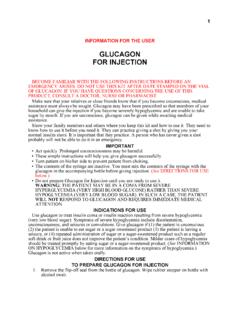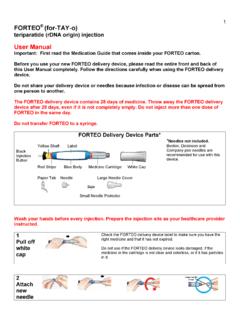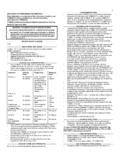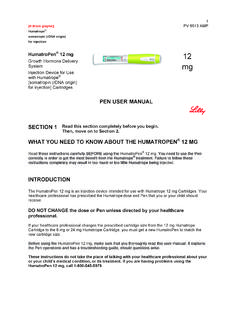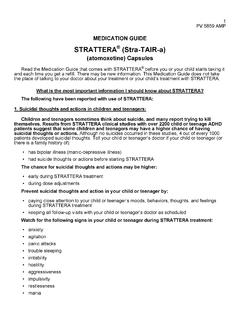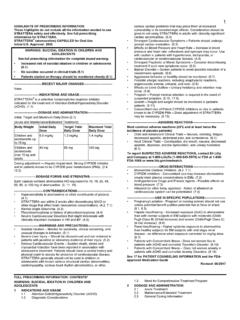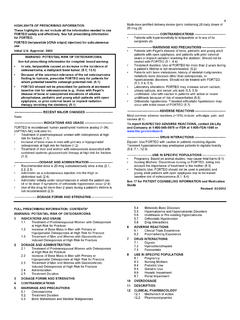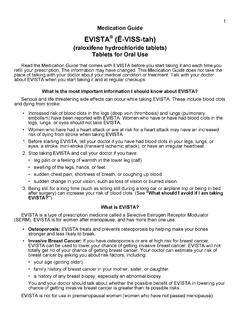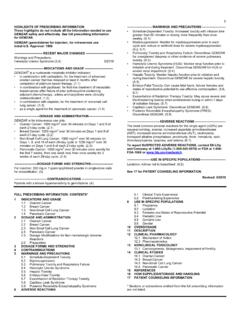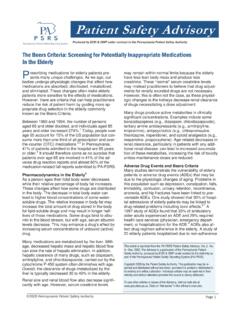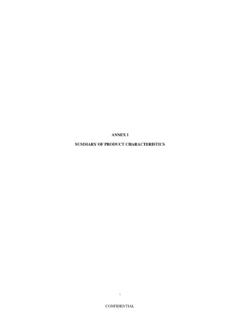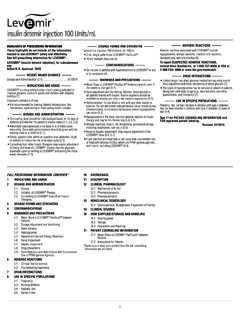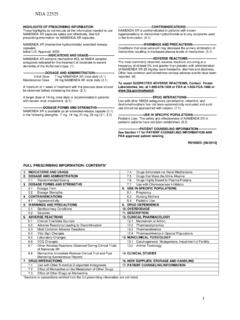Transcription of HIGHLIGHTS OF PRESCRIBING INFORMATION …
1 1. HIGHLIGHTS OF PRESCRIBING INFORMATION Hypoglycemia: May be life-threatening. Increase frequency of These HIGHLIGHTS do not include all the INFORMATION needed to use glucose monitoring with changes to: insulin dosage, BASAGLAR safely and effectively. See full PRESCRIBING co-administered glucose lowering medications, meal pattern, INFORMATION for BASAGLAR physical activity; and in patients with renal or hepatic impairment and hypoglycemia unawareness. ( , ). BASAGLAR (insulin glargine injection), for subcutaneous use Medication Errors: Accidental mix-ups between insulin products Initial Approval: 2000 can occur. Instruct patients to check insulin labels before injection. ( ). --------------------------- RECENT MAJOR CHANGES -------------------------- Hypersensitivity reactions: Severe, life-threatening, generalized Dosage and Administration ( ) 06/2016 allergy, including anaphylaxis, can occur. Discontinue ---------------------------- INDICATIONS AND USAGE --------------------------- BASAGLAR, monitor and treat if indicated.
2 ( , ). Hypokalemia: May be life-threatening. Monitor potassium levels in BASAGLAR is a long-acting human insulin analog indicated to patients at risk of hypokalemia and treat if indicated. ( ). improve glycemic control in adults and pediatric patients with type 1 Fluid retention and heart failure with concomitant use of diabetes mellitus and in adults with type 2 diabetes mellitus. (1) thiazolidinediones (TZDs): Observe for signs and symptoms of Limitations of Use: heart failure; consider dosage reduction or discontinuation if heart Not recommended for treating diabetic ketoacidosis. (1) failure occurs. ( ). ------------------------DOSAGE AND ADMINISTRATION----------------------- ------------------------------- ADVERSE REACTIONS ------------------------------ Individualize dosage based on metabolic needs, blood glucose Adverse reactions commonly associated with insulin glargine products monitoring, glycemic control, type of diabetes, prior insulin use.
3 (5% or greater incidence) are: ( , , ) Hypoglycemia, allergic reactions, injection site reaction, Administer subcutaneously once daily at any time of day, but at lipodystrophy, pruritus, rash, edema, and weight gain. ( ). the same time every day. ( ). Rotate injection sites to reduce the risk of lipodystrophy. ( ) To report SUSPECTED ADVERSE REACTIONS, contact Eli Lilly Closely monitor glucose when converting to BASAGLAR and and Company at 1-800-LillyRx (1-800-545-5979) or FDA at 1-800- during initial weeks thereafter. ( ) FDA-1088 or Do not dilute or mix with any other insulin or solution. ( ) ------------------------------- DRUG INTERACTIONS ------------------------------ ----------------------DOSAGE FORMS AND STRENGTHS--------------------- Drugs that affect glucose metabolism: Adjustment of insulin dosage may be needed; closely monitor blood glucose. (7). Injection: 100 units/mL (U-100) in 3 mL prefilled BASAGLAR Anti-Adrenergic Drugs ( , beta-blockers, clonidine.)
4 KwikPen delivery device. (3) guanethidine, and reserpine): Signs and symptoms of ------------------------------- CONTRAINDICATIONS ------------------------------ hypoglycemia may be reduced or absent. (7). During episodes of hypoglycemia. (4) ------------------------USE IN SPECIFIC POPULATIONS----------------------- Hypersensitivity to BASAGLAR or one of its excipients. (4) Pregnancy: Use during pregnancy only if the potential benefit ------------------------ WARNINGS AND PRECAUTIONS ----------------------- justifies the potential risk to the fetus. ( ). Never share a BASAGLAR KwikPen between patients, even if the needle is changed. ( ) See 17 for PATIENT COUNSELING INFORMATION and FDA- Hyper- or hypoglycemia with changes in insulin regimen: Carry approved patient labeling. out under close medical supervision. ( ) Revised: 6/2016. FULL PRESCRIBING INFORMATION : CONTENTS*. 1 INDICATIONS AND USAGE Geriatric Use Renal Impairment 2 DOSAGE AND ADMINISTRATION hepatic Impairment Important Administration Instructions Obesity General Dosing Instructions Initiation of BASAGLAR Therapy 10 OVERDOSAGE.
5 Changing to BASAGLAR from Other Insulin Therapies 11 DESCRIPTION. 3 DOSAGE FORMS AND STRENGTHS 12 CLINICAL PHARMACOLOGY. 4 CONTRAINDICATIONS Mechanism of Action Pharmacodynamics 5 WARNINGS AND PRECAUTIONS Pharmacokinetics Never Share a BASAGLAR KwikPen Between Patients Hyperglycemia or Hypoglycemia with Changes in Insulin 13 NONCLINICAL TOXICOLOGY. Regimen Carcinogenesis, Mutagenesis, Impairment of Fertility Hypoglycemia 14 CLINICAL STUDIES. Medication Errors Overview of Clinical Studies Hypersensitivity and Allergic Reactions Clinical Studies in Adult and Pediatric Patients with Type 1. Hypokalemia Diabetes Fluid Retention and Heart Failure with Concomitant Use of Clinical Studies in Adults with Type 2 Diabetes PPAR-gamma Agonists 16 HOW SUPPLIED/STORAGE AND HANDLING. 6 ADVERSE REACTIONS How Supplied Clinical Trial Experience Storage and Handling Immunogenicity 17 PATIENT COUNSELING INFORMATION . Postmarketing Experience 7 DRUG INTERACTIONS * Sections or subsections omitted from the full PRESCRIBING INFORMATION 8 USE IN SPECIFIC POPULATIONS are not listed.
6 Pregnancy Nursing Mothers Pediatric Use 2. FULL PRESCRIBING INFORMATION . 1 INDICATIONS AND USAGE.. BASAGLAR is indicated to improve glycemic control in adults and pediatric patients with type 1 diabetes mellitus and in adults with type 2 diabetes mellitus. Limitations of Use BASAGLAR is not recommended for the treatment of diabetic ketoacidosis. 2 DOSAGE AND ADMINISTRATION. Important Administration Instructions Always check insulin labels before administration [see Warnings and Precautions ( )]. Train patients on proper use and injection technique before initiating BASAGLAR. Visually inspect BASAGLAR KwikPen for particulate matter and discoloration prior to administration. Only use if the solution is clear and colorless with no visible particles. Inject between 1 and 80 units per injection. Administer BASAGLAR subcutaneously into the abdominal area, thigh, or deltoid, and rotate injection sites within the same region from one injection to the next to reduce the risk of lipodystrophy [see Adverse Reactions ( )].
7 Do not dilute or mix BASAGLAR with any other insulin or solution as the onset of action or time to peak effect of BASAGLAR and the mixed insulin may be altered in an unpredictable manner. Do not administer intravenously or via an insulin pump because this could result in severe hypoglycemia. General Dosing Instructions In patients with type 1 diabetes, BASAGLAR must be used concomitantly with short-acting insulin. Inject BASAGLAR subcutaneously once daily at any time of day but at the same time every day. Individualize and titrate the dosage of BASAGLAR based on the individual's metabolic needs, blood glucose monitoring results and glycemic control goal. Dosage adjustments may be needed with changes in physical activity, changes in meal patterns ( , macronutrient content or timing of food intake), during acute illness, or changes in renal or hepatic function and should be made under medical supervision with appropriate glucose monitoring [see Warnings and Precautions ( )].
8 Initiation of BASAGLAR Therapy The recommended starting dose of BASAGLAR in patients with type 1 diabetes should be approximately one- third of the total daily insulin requirements. Short- or rapid-acting, pre-meal insulin should be used to satisfy the remainder of the daily insulin requirements. The recommended starting dose of BASAGLAR in patients with type 2 diabetes is units/kg or up to 10 units once daily. One may need to adjust the amount and timing of short- or rapid-acting insulins and dosages of any anti-diabetic drugs. Changing to BASAGLAR from Other Insulin Therapies If changing patients from another insulin glargine product, 100 units/mL, to BASAGLAR, the dose of BASAGLAR should be the same as the other insulin glargine product, 100 units/mL, and the time of day for administration should be determined by the physician. If changing patients from a once-daily insulin glargine product, 300 units/mL, to once-daily BASAGLAR, the recommended initial BASAGLAR dosage is 80% of the insulin glargine product, 300 units/mL, dose that is being discontinued.
9 This dosage reduction will lower the likelihood of hypoglycemia [see Warnings and Precautions ( )]. If changing from a treatment regimen with an intermediate- or long-acting insulin (other than an insulin glargine product, 100 units/mL) to a regimen with BASAGLAR, a change in the dose of the basal insulin may be required and the amount and timing of shorter-acting insulins and doses of any anti-diabetic drugs may need to be adjusted. If changing patients from twice-daily NPH insulin to once-daily BASAGLAR, the recommended initial BASAGLAR dosage is 80% of the total NPH dosage that is being discontinued. This dosage reduction will lower the likelihood of hypoglycemia [see Warnings and Precautions ( )]. 3 DOSAGE FORMS AND STRENGTHS. Available as a clear, colorless, sterile solution for injection: 100 units per mL (U-100) in a 3 mL prefilled delivery device (BASAGLAR KwikPen ). 4 CONTRAINDICATIONS. BASAGLAR is contraindicated: 3.
10 During episodes of hypoglycemia [see Warnings and Precautions ( )]. In patients with hypersensitivity to insulin glargine or one of its excipients [see Warnings and Precautions ( )]. 5 WARNINGS AND PRECAUTIONS. Never Share a BASAGLAR KwikPen Between Patients BASAGLAR KwikPens must never be shared between patients, even if the needle is changed. Sharing poses a risk for transmission of blood-borne pathogens. Hyperglycemia or Hypoglycemia with Changes in Insulin Regimen Changes in insulin strength, manufacturer, type, or method of administration may affect glycemic control and predispose to hypoglycemia [see Warnings and Precautions ( )] or hyperglycemia. These changes should be made cautiously and only under close medical supervision, and the frequency of blood glucose monitoring should be increased. For patients with type 2 diabetes, dosage adjustments of concomitant anti-diabetic products may be needed.
